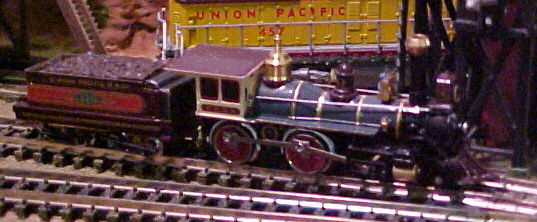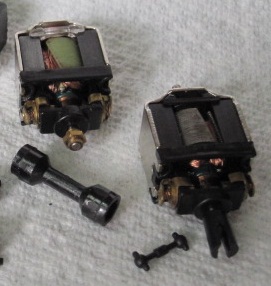



Introduced: 1979
These cute little models come in two basic flavors - the "Jupiter" and the "American", with the differences between the two basically boiling down to minor variations in shell detailing. The center dome and bell are different between the two. The Jupiter has a diamond shaped smokestack, whereas the American has a straight stack. The boiler on the American is a bit longer, with its smokebox sticking out a bit farther than the Jupiter. Lastly, the headlight on the American is mounted to the smokebox, whereas the Jupiter's headlight sits on a little platform extending out from the smokebox. Neither version has any sort of lighting.

These locos employ an ingenious little tender drive mechanism (with a driveshaft running from the tender into the cab). And as is their wont, Bachmann has revised these models numerous times over the years. Unfortunately, Bachmann rarely announces such changes so much of the timeline proposed below is simply guesswork.
The initial release (marked "Hong Kong" on the locomotive bottom plate) has kind of a strange motor situation - a completely open straight-wound 3-poler with a couple of ala carte magnets wedged in on either side. The driveshaft uses hex-cups on either end. The driver gears are fatter than the ones used in later releases and have fewer teeth (the latter making for an overly high starting speed and overall poor performance at low throttle settings). The boiler band immediately behind the center dome is actually molded into the shell (said band would be eliminated from later shells and simply painted on - still scratching my head over that one). The tender design on this first version is a bit different from later versions (to accommodate the weirdo motor), so one of the newer motors will not simply swap in (not without some modification, anyway). The weights in this first version are noticeably heavier than the ones used in later versions.

Circa 1985, the tender mechanism was revised to include a more typical one-piece motor (3-pole and skew-wound). The bottom plate is stamped "China" rather than "Hong Kong". Also, the driver gearing was changed, allowing for greater reduction and much improved slow-speed performance.

Circa 1998, the driveshaft between the engine and tender was changed - from "hex cup" style connectors to "little ball with pins" connectors. My guess is that the latter version is more likely to stay connected (and less likely to come disconnected and go flying off into the ether). There may be other less tangible benefits with the newer design (less friction, etc), but I'll leave that for the rocket scientists to sort out.

Circa 2014, the metal gears were replaced with black plastic gears. Also, some of the screws were changed, as was the way the pilot truck mounts to the locomotive chassis (old version on top, latest version below) -

Performance is going to vary depending on the version - with the newer releases running markedly better than the older ones. The first version is reputedly a pretty poor runner (which no doubt explains all the subsequent changes). As for the most recent version, performance out of the box is surprisingly good - smooth, quiet, nimble throttle response, nice slow speed creep, etc. And I'm told that they run even better after a lengthy break-in period. All four of the drivers are equipped with traction tires on all versions, so I'm assuming they'll pull a reasonable number of cars (despite their overall light weight).
The main problem I've run into with all of these is the extremely limited pickup footprint (all pickup coming solely from the eight tiny tender wheels), making it difficult to get them through insulated frog turnouts without stalling. Also, they have these crazy fat wheels on both the tender and the pilot that occasionally cause problems with derailing through turnouts and grade crossings and suchlike (one's specific track situation being the major determining factor here).
As of this writing (2014), these models are still available from Bachmann (either separately or as part of train sets). The newer runs come with higher quality paint jobs, blackened wheels and Bachmann's non-automatic (one piece) knuckle coupler on the tender. The most recent version comes with an E-Z Mate automatic coupler (earlier runs came with Rapido-style couplers).
To disassemble the engine, simply remove the screw on the chassis bottom-plate. To disassemble the tender, first remove the screws on the bottom and then take off the trucks, pickup springs and contact plates. To get at the motor you have to pry the large weight off of the forward end of the chassis. Once that's removed, the motor should slide right out.
Grade: C for the first version, and B for the later versions (with all of the above-mentioned caveats vis'a'vis turnouts and grade crossings)
Reviewed: 4/80 Model Railroader ("The Bachmann American is the first mass-produced, readily available model of this locomotive type and era in N scale, and it is a good one. The sample shown is painted and lettered to represent the UP's Promontory Point engine, no. 119. The 119 was a coal burner, and besides the paint job the model has the extended smokebox and straight smokestack of the prototype. Bachmann also uses the same basic model to represent CP no. 60, the Jupiter, and that model has the shorter smokebox and balloon stack typical of the old wood-burning steamers. In smaller details the model does not exactly represent either of these engines, but it does have the features of a typical 4-4-0. What's more, it is very accurately scaled. In most important dimensions it is within 2 or 3 inches of the prototype 119, which in so small a model is all that can be asked. The model's chief scale discrepencies are the width over its cylinders and the height of its tender: the cylinders are widely spaced to allow the pilot truck to swing for sharp curves, and the tender is a little oversize to enclose the motor. The crosshead guides and the bell bracket are also on the bulky side, but they don't seriously hurt the model's overall appearance...
The design of the tender demonstrates the ingenuity required to power a model this size. The plastic tender shell is actually the motor case, holding the bearing blocks and magnets in place around the 3-pole armature. The tender wheels don't have normal axles, but rather turn freely on stub axles cast as parts of wheel-support brackets, which also include the contact spring retainers. The brackets on either side of the tender are held in place and insulated by the plastic truck frames. Coil springs which ride on top of the brackets do triple duty: they hold the brackets in place in the truck frames, complete the current path from the wheel support brackets to brass contact plates on the tender bottom, and keep the tender from rocking due to motor torque - a common problem with tender drives. A hex-cup universal shaft connects the motor to the worm shaft in the locomotive. Both driving axles are geared, and all four drivers have rubber traction tires. Underframe extensions and other cast-metal pieces fill the plastic locomotive shell to provide weight.
This model is a smooth runner, but it has a rocking motion which seems to be caused by uneveness of its traction tires. The minimum speed is acceptable if not ideal, and the engine will start smoother and run slower on pulse power... The maximum speed is simply excessive, and this engine reaches realistic maximum speeds between 6 and 7 volts. The pulling power is good for an engine this light and equals about 15 or 16 average cars... The tender body becomes noticeably warm after the engine has run continuously for a while, so it probably operates near its maximum safe current rating. There is no empty space to be crammed with additional weight, so there is little danger of overloading the motor. The motor is noisier when run on pulse power, and I'd advise checking the tender frequently when you begin running the locomotive on pulse power to avoid damage. The locomotive's wheels were all slightly tight in gauge... but the tender wheels are correct. This is fortunate, as the locomotive wheels are easy to regauge with a small wheelpuller, but the tender wheels, with their unusual support brackets, would be difficult to adjust...
The model's finish is flat and the lettering and striping are neat. There is a little overspray here and there, and some of the less attractive details could stand to be deemphasized with darker paint. The fuel load in the tender is brown and looks something like wood, but if it were black it could serve equally well as coal. Bachmann's American should be a popular addition to the range of N scale locomotives. It opens up the nineteenth century era for N scale modeling, and, as many rebuilt and modernized Americans lasted into this century, could also be used on model railroads of later periods. Even on an up-to-date diesel-powered line, the American would make a nice fan trip locomotive. $24.98")